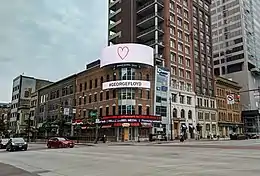
The 100 percent corner is the busiest area in a city. Often it is a crossroads of several major streets, and the place with the highest land value and/or where grid plan numbering is based upon.[1] The term is also used for the place for ideal real estate projects, sometimes considered the intersection of two highways in a suburban area.[2] The terms "hundred percent location", "hundred percent corner", or "peak land value intersection" may also be used.[3][4]
The 100 percent corner is used in research as part of a method to determine a city's downtown area, by measuring a radius (e.g. one mile) from the central intersection.[5]
- Examples
- Broad and High Streets in Columbus, Ohio[6]
- Fayette Street and South Salina Street in Syracuse, New York[7][8]
- Fourth and Muhammad Ali Boulevard in Louisville, Kentucky[9]
- Church and Chapel Streets in New Haven, Connecticut[10][11]
See also
References
- ↑ Sohmer, Rebecca R.; Lang, Robert E. (May 2001). "Downtown Rebound" (PDF). Fannie Mae Foundation and Brookings Institution Center on Urban and Metropolitan Policy.
- ↑ "The '100 Percent Corner' Moves Downtown". Mithun. January 5, 2015.
- ↑ "IJSRST, International Journal of Scientific Research in Science and Technology" (PDF).
- ↑ Urban Geography. Wiley. 1979. ISBN 9780471032922.
- ↑ Redefining Urban and Suburban America: Evidence from Census 2000. Brookings Institution Press. 30 January 2007. ISBN 9780815708858.
- ↑ "National Register of Historic Places Registration Form" (PDF). National Park Service. Retrieved December 21, 2020.
- ↑ "A Syracuse Rite Aid conjures historic Woolworth's: Changing with the city around it". syracuse. February 26, 2013.
- ↑ "In Syracuse, at Fayette and Salina: What kind of park best suits downtown's '100 percent corner'?". syracuse. February 25, 2015.
- ↑ Runyon, Keith (April 16, 2015). "The Resurgence of Fourth and Muhammad Ali, Downtown Louisville's '100 Percent Corner'". 89.3 WFPL News Louisville.
- ↑ Euler, Laura (April 5, 2016). "A Traditional Darien Mansion is Updated and Expanded Hamptons Style". Curbed Hamptons.
- ↑ City: Urbanism and Its End. Yale University Press. October 2008. ISBN 9780300134759.
This article is issued from Wikipedia. The text is licensed under Creative Commons - Attribution - Sharealike. Additional terms may apply for the media files.